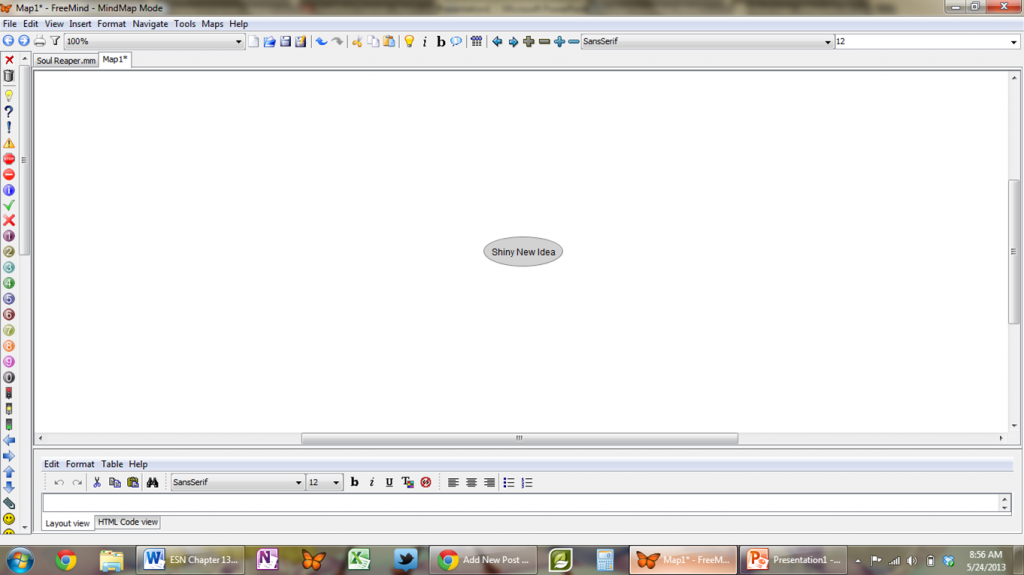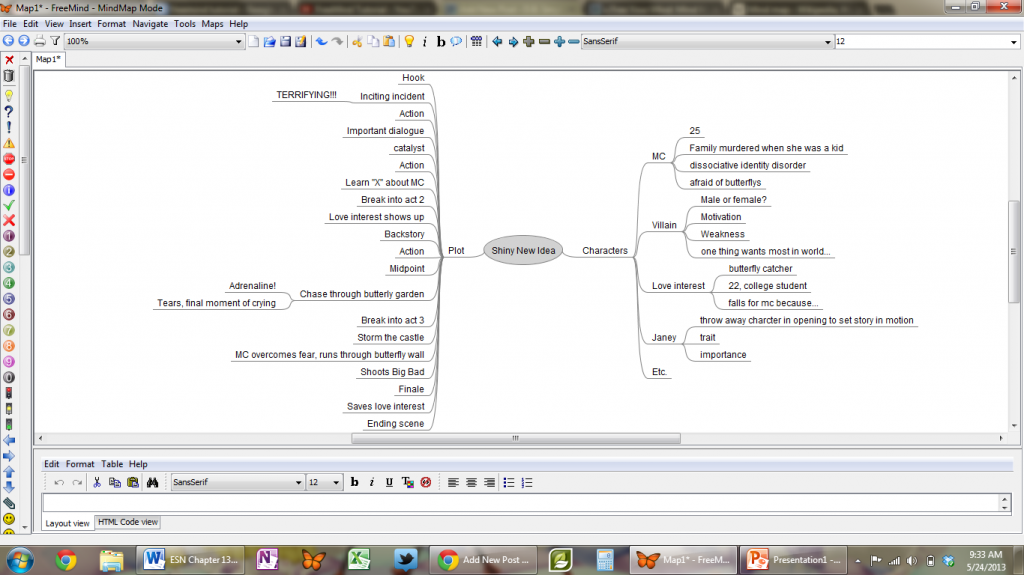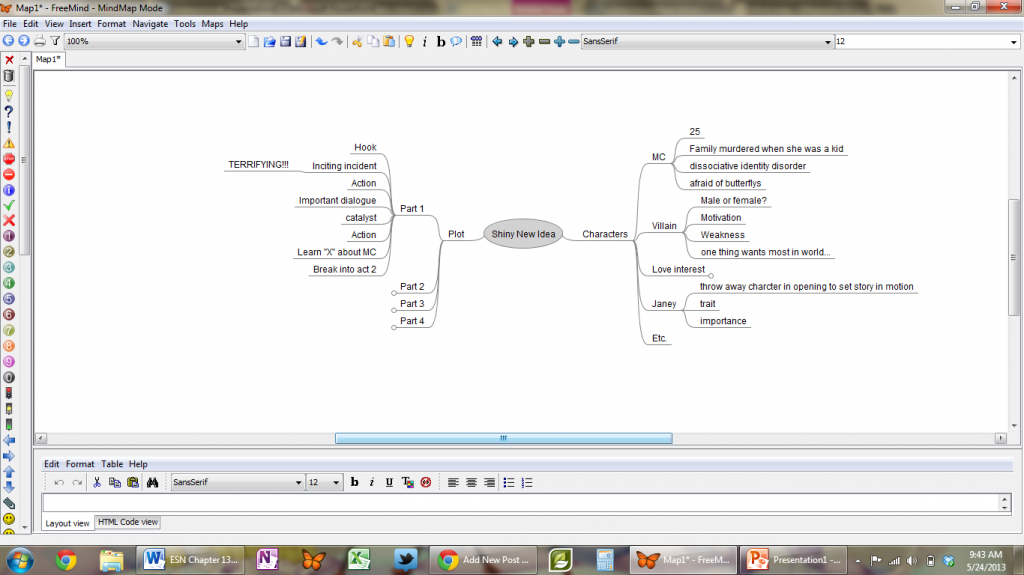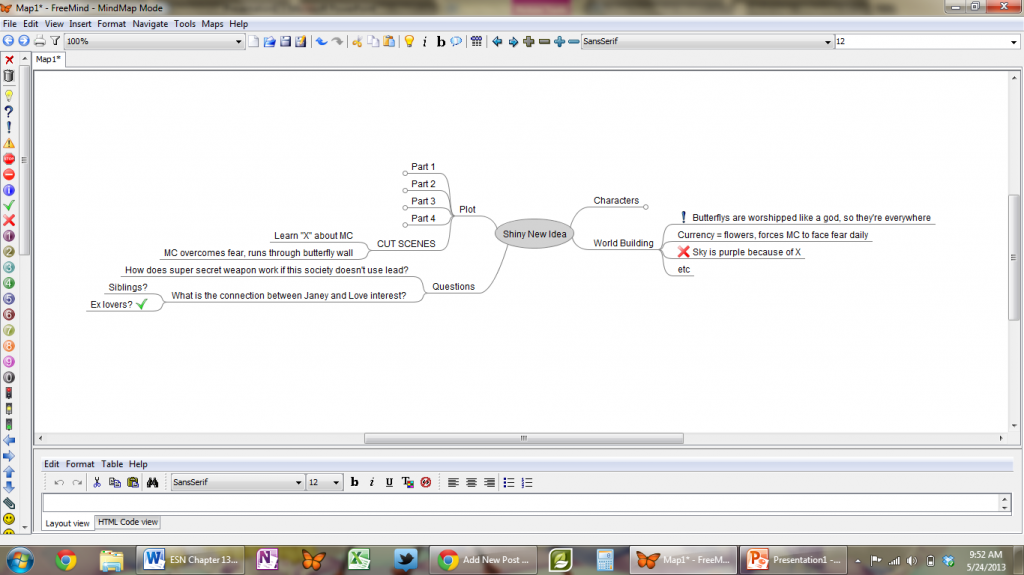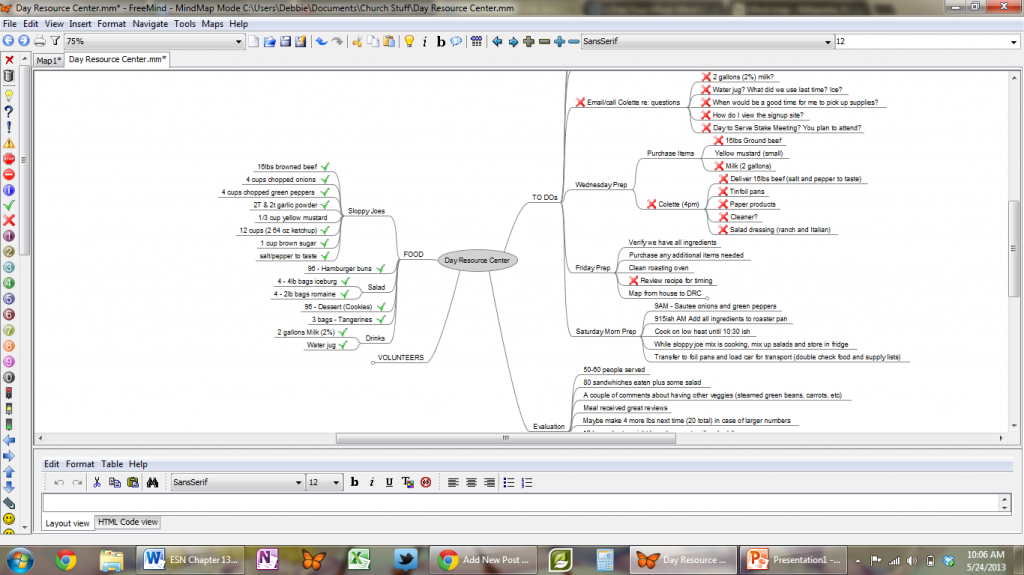
Copyright © 2010 William Ross via Flickr, cc Some rights reserved
I. Love. Mind mapping!
I probably learned this skill way back in elementary school–or maybe it was Jr. High?–for brainstorming. You know. Write your main idea in the center and circle it, add tangent lines for all the pieces connected to said idea, group like with like. It usually turns out looking like a snowflake or spider web.
But until recently I had no idea I could use it for tracking the chaos I call novel writing! At wits end, I “phoned a friend” and begged her to show me her process for staying organized. And what she showed me blew. my. mind. Though long and somewhat involved, her process FELT organic… natural. A way to organize my brain that didn’t feel like control and straight jackets and suffocation.
It freed my mind rather than imprisoning it with structure.
I’m not going to take you though Lina’s entire process of gathering, organizing, and expanding novel ideas. Instead we’re going to zero in on that part of the process between hammering out the major plot points (ie. Save the Cat! beat sheet) and writing your book.
So… mind mapping… what is it, exactly? Wiki explains that a mind map is “is a diagram used to visually outline information. It is often created around a single word or text, placed in the center, to which associated ideas, words and concepts are added.” The key, for me, is VISUAL. An added bonus is that mind maps are somewhat non-linear in structure, so I get bubbles and off shoots and random notes rather than line after line of text found in an outline. They feel intuitive rather than official (which means I don’t feel guilty when I have to change one!)
And they are more than just capturing your plot structure. You can have a place for characters, questions left unanswered, world building ideas, etc. The possibilities are whatever you need them to be!
So let’s walk through this with Shiny New Novel.
In the center of your mind map will be your title.
Next I like to add the two main components I know I’ll need… plot and characters.
Now for capturing all my brainstorming. On the plot side I’m going to capture everything that pops into my head. I already have a good idea of the major plot points because I completed my beat sheet, but I also want to make sure to capture everything in between. What I LOVE about using the software vs. writing out my mind map is that I can MOVE items in the software. Nothing is permanent. This frees up my crazy so I can dump ideas without worrying about getting it perfect the first time. So write away! Capture anything and everything you want to see happen in your novel. It doesn’t have to be detailed, you just need enough to grab the essence of the idea so you can expound on it later. I love that Lina also captures moods she wants or they type of pacing she’s looking for.
I tend to bounce back and forth between plot and characters as new people pop into my plot. I start with my MC, villain and love interest and then go from there. Sometimes all I’m capturing is a name, but I like to capture any details as they come to me. The level of my character detail is not extensive. I keep a file of pictures, detail, and back story for each character somewhere else. The purpose of the map is to give me a quick view (and helps me keep the spelling of character names and titles consistent as I write!).
Once I have all my scenes laid out, I add one more level of organizing for me–dividing the scenes into the 3 Act structure (or 4 parts). This is EASY with the drag and drop feature. Also, because Free Mind allows you to open or collapse each node, organizing the scenes into parts means I don’t have to look at the whole story at once (which leads to hyperventilating and feelings of dread). I simply collapse the pieces I’m not working on. Easy peasy!
As you work through you’re own mind map you’ll discover the various pieces you want to add. I like to have a place for questions I need to answer, world building information, and cut scenes. Free mind also has icons that you can add to any of your line items. This means that when I figure out the answer to a question, I can add a check mark or an X. You’ll figure out what works best for you as you use it.
I’m still working through my process, but Lina says her mind maps take less than an hour. And by the time she is done, she has her entire road map in place for her novel! Her drafting is super fast because she’s already brainstormed her scenes and only has to write from point to point.
Will things still change as you write? Of course. That just means a quick tweak to the mind map. Drag and drop the old, enter the new. Keep your map up to date you and you will have all the main points you need for creating a synopsis later! No more coming through your text trying to remember what went where. Your book at a glance!!! A huge win for the visual peeps among us!
I hope that made sense. It can seem daunting at the start, but it’s really quite easy. I even use mind mapping for non-writing projects now! Essentially anything that stresses me out, from moving my house to preparing meals for a local resource center. Once I can see all the pieces, my angst levels drop dramatically!
If this system doesn’t work for you, don’t stress it. Do what works best for your process. This allowed me to harness my pinball brain rather than getting beat to a pulp by it (any ball traveling at a zillion mph is bound to do some damage!).
Let me know if you have questions. If I can’t answer them, I’m sure we can find someone (ahem… LINA) who can.
Happy writing!
Download FreeMind Software HERE.
View FreeMind Tutorial HERE.

FreeMind Software Logo
See page for author [GPL, GFDL or CC-BY-SA-3.0], via Wikimedia Commons
And because one can’t say “Free Your Mind” without evoking En Vogue…
